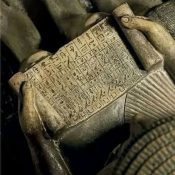The great Pyramid disappeared

The great Pyramid disappeared
🏺 The Great Pyramid That Disappeared
1. The Beginning of the Mystery (1951)
In 1951, archaeologist and Egyptologist Zakaria Ghoneim, then serving as Chief Inspector of Antiquities in Saqqara, began an investigation that would challenge long-held assumptions about Egypt’s ancient necropolis. His primary responsibility was the protection and preservation of Saqqara’s antiquities—one of Egypt’s most significant archaeological sites.
2. The Puzzle of the Missing Pyramids
Zakaria was deeply familiar with the Step Pyramid of Saqqara, built by King Zoser (Djoser) of the 3rd Dynasty. However, he was perplexed by one critical mystery:
Why had no pyramids belonging to Zoser’s successors ever been discovered?
Despite Saqqara’s prominence as the main burial ground of ancient Memphis, only one confirmed pyramid from the 3rd Dynasty had been found.
3. A Scholar’s Determination
In his book “The Buried Pyramid,” Zakaria expressed his conviction:
“It seemed strange to me that in this, the most important necropolis of Memphis, there is only one monument which can definitely be ascribed to a 3rd Dynasty king.”
While his colleagues were skeptical, arguing that pyramids could hardly remain hidden, Zakaria remained undaunted.
4. The Search Begins
Driven by his belief that more pyramids must lie buried beneath the sands of Saqqara, Zakaria Ghoneim launched a bold archaeological search—one that would soon uncover one of Egypt’s most fascinating lost monuments.
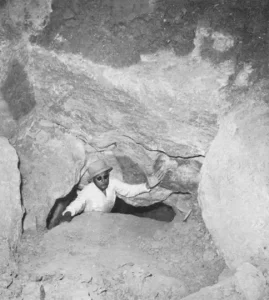
🔍 The Discovery of the Lost Pyramid
1. Years of Relentless Work (1951–1954)
For three years, Zakaria Ghoneim and his dedicated team worked tirelessly in the sands of Saqqara. Their perseverance paid off in 1954, when they could finally confirm what Zakaria had long believed — they had indeed found a pyramid.
However, what emerged from the excavation was only the lower portion of a step pyramid, raising new and puzzling questions.
2. The Missing Upper Stages
The discovery sparked a crucial debate:
-
Where were the upper levels of the pyramid?
-
Had the pyramid never been completed?
-
Or had it once been finished and later dismantled by ancient stone robbers seeking easy building materials?
These mysteries deepened the intrigue surrounding the site.
3. Zakaria’s Conclusion
After careful analysis, Zakaria Ghoneim concluded that the pyramid was never completed, likely due to the premature death of the king who commissioned it.
His reasoning was based on the absence of facing stones—the finely cut outer casing that typically adorned finished pyramids. While it was possible that stone thieves had removed them, the overall evidence pointed to incompletion rather than destruction.
4. The Scale of the Monument
What remained of the structure stood at a modest 23 feet (7 meters) in height. Yet, if it had been completed, architectural calculations showed it would have reached an impressive 230 feet (70 meters) — making it 33 feet (10 meters) taller than the renowned Step Pyramid of King Zoser.
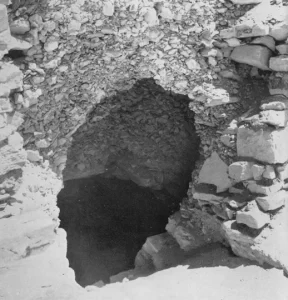
🏺 The Breakthrough Discovery
1. A Find Beyond Gold and Jewels
Amidst the sands and stones of Saqqara, Zakaria Ghoneim made what would become the most significant discovery of his career — and one of the most important finds of its time.
It was not gold or silver, nor an object of great beauty or ornamentation.
Instead, it was something far more valuable to an archaeologist: information.
2. The Sealed Pottery Jars
Inside the excavation site, the team uncovered a collection of small pottery jars, each carefully stoppered with clay and impressed with royal seals.
Upon close examination, the seal impressions revealed the name:
“Sekhem-Khet” – meaning “Powerful of Body.”
This inscription identified the owner of the pyramid — King Sekhem-Khet, the successor of King Zoser and ruler of Egypt’s 3rd Dynasty.
3. Solving the Pyramid’s Mystery — or Not?
The discovery of Sekhem-Khet’s name appeared to answer one of the great archaeological questions:
Had this pyramid ever been completed, or was it left unfinished?
Zakaria Ghoneim concluded that the pyramid was never finished, likely abandoned after the untimely death of the king.
Yet, despite his conclusion, the mystery remained alive — a question that would continue to puzzle Egyptologists for generations to come.
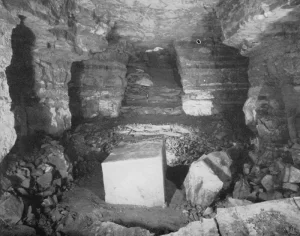
🏗️ The Great Pyramid That Almost Disappeared
1. The Fate of Many Ancient Monuments
Throughout Egypt’s long history, many pyramids were dismantled and hundreds completely vanished, their stones taken by later builders seeking ready-cut materials for new constructions.
Had fate not intervened, the Great Pyramid of Giza might have shared the same tragic destiny.
2. Muhammad Ali Pasha’s Ambitious Vision
Between 1830 and 1847, Muhammad Ali Pasha, the powerful Governor of Egypt, launched grand building projects that would forever change Cairo’s skyline.
Among these were the Nile Arches and the magnificent Muhammad Ali Mosque, built atop the Citadel Mountain — a symbol of his power and legacy.
3. A Dangerous Proposal
In his quest for materials, Muhammad Ali initially intended to dismantle the Great Pyramid to reuse its colossal limestone blocks for his mosque’s construction.
Such an act would have erased one of humanity’s greatest monuments from history.
4. The Engineer’s Clever Intervention
Fortunately, an ingenious engineer, aware of the pyramid’s priceless cultural value, devised a clever economic argument to dissuade the ruler.
He explained that:
-
The cost of transporting one pyramid stone (weighing about five tons) would be 10 piasters.
-
The cost of cutting and transporting the same amount of stone from a nearby quarry would only be 8 piasters.
This simple yet strategic calculation convinced Muhammad Ali that using new stone was cheaper than dismantling the pyramid.
5. A Monument Saved by Wisdom
Thus, through the wisdom and courage of those engineers, the Great Pyramid was spared from destruction — surviving not only the sands of time but also the ambitions of modern rulers.

Hundreds of years before that, specifically in the year 813 AD, Caliph Al-Ma’mun took power. His men convinced him that the pyramid was full of treasures.
The Caliph sent his men to search for the treasures inside the pyramid, and they actually dug a corridor inside the pyramid which reached a room known as the burial chamber, but they left work because they did not find something valuable inside the pyramid، and till today the tourists are able to go inside the pyramid through the entrance gateway which has bees dugged by Caliph Maamuon workmen.
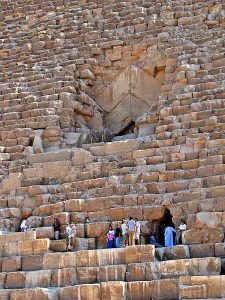
Muhammad Ali pasha Mosque
The Great Mosque of Muhammad Ali Pasha or Alabaster Mosque is a mosque situated in the Citadel of Cairo in Egypt and was commissioned by Muhammad Ali Pasha between 1830 and 1848.
Situated on the summit of the citadel, this Ottoman mosque, the largest to be built in the first half of the 19th century, is, with its animated silhouette and twin minarets, the most visible mosque in Cairo.
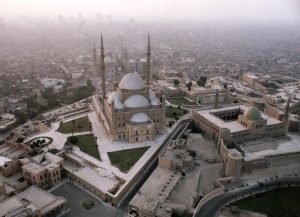
The mosque was built in memory of Tusun Pasha, Muhammad Ali’s oldest son, who died in 1816.
This mosque, along with the citadel, is one of the landmarks and tourist attractions of Cairo and is one of the first features to be seen when approaching the city any direction.

The mosque was built on the site of old Mamluk buildings in Cairo’s Citadel between 1830 and 1848, although not completed until the reign of Said Pasha in 1857. The architect was Yusuf Bushnak from Istanbul and its model was the Sultan Ahmed Mosque in that city. The ground on which the mosque was erected was built with debris from the earlier buildings of the Citadel.
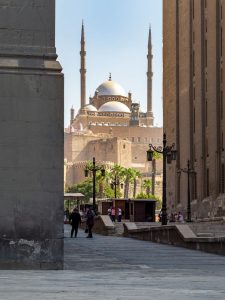
Before completion of the mosque, the alabastered panels from the upper walls were taken away and used for the palaces of Abbas I. The stripped walls were clad with wood painted to look like marble. In 1899 the mosque showed signs of cracking and some inadequate repairs were undertaken. But the condition of the mosque became so dangerous that a complete scheme of restoration was ordered by King Fuad in 1931 and was finally completed under King Farouk in 1939.


Muhammad Ali Pasha was buried in a tomb carved from Carrara marble, in the courtyard of the mosque. His body was transferred here from Hosh al-Basha in 1857.
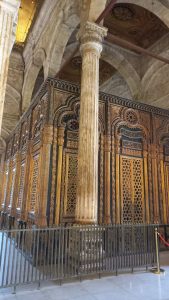
Urban and architectural
Muhammad Ali chose to build his state mosque entirely in the architectural style of his former overlords, the Ottomans, unlike the Mamluks who, despite their political submission to the Ottomans, stuck to the architectural styles of the previous Mamluk dynasties.
The mosque was built with a central dome surrounded by four small and four semicircular domes. It was constructed in a square plan and measured 41×41 meters. The central dome is 21 meters in diameter and the height of the building is 52 meters. Two elegant cylindrical minarets of Turkish type with two balconies and conical caps are situated on the western side of the mosque, and rise to 82 meters.
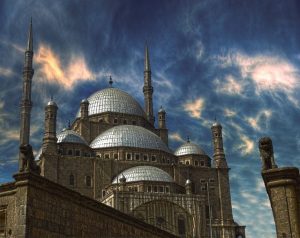
The use of this style, combined with the presence of two minarets and multiple half-domes surrounding the central dome — features reserved for mosques built on the authority of the Sultan — were a defiant declaration of de facto Egyptian independence.
The main material is limestone but the lower storey and forecourt is tiled with alabaster up to 11,3 meters. The external facades are severe and angular and rise about four storeys until the level of the lead-covered domes.
The mihrab on the southeastern wall is three storeys high and covered with a semicircular dome. There are two arcades on the second storey, rising on columns and covered with domes. Although there are three entrances on each side of the forecourt, the usual entry is through the northeastern gate. The forecourt measures 50×50 meters. It is enclosed by arched riwaks rising on pillars and covered by domes.
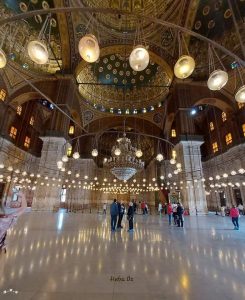
There is a brass clock tower in the middle of the northwestern riwak, which was presented to Muhammad Ali by King Louis Philippe of France in 1845. The clock was reciprocated with the obelisk of Luxor now standing in Place de la Concorde in Paris.

The interior has a measure of 41×41 meters and gives a great feeling of space. The use of two levels of domes gives a much greater sense of space than there actually is. The central dome rises on four arches standing on colossal piers. There are four semicircular domes around the central dome. There are four smaller domes on the corners as well. The domes are painted and embellished with motifs in relief. The walls and pillars are covered with alabaster up to 11 meters high.
Recent Posts
Fotos
Sunlight
The Egyptians are still talking like ancestors
Tags


